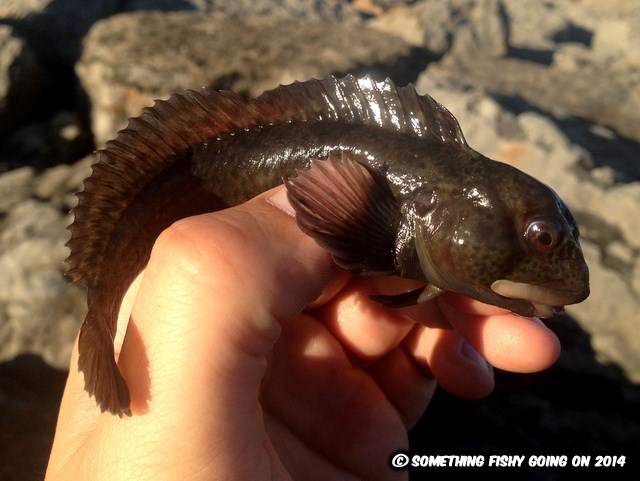As planned I returned to Torness Power Station outflow today to have another go at catching a golden grey mullet. The first few hours were very frustrating indeed, watching dozens of juvenile mullet hoovering up my groundbait but ignoring the piece of bread on my hook. Once forced to retreat to the sea defences by the incoming tide I had to wait a short while for the tide to rise a little further before I could continue fishing for mullet. I killed time catching blennies from between the rocks after collecting a solitary limpet to use as bait.
 |
| One of many blennies that I caught on slivers of limpet. An underrated bait I think that stays on the hook very well. |
Once there was enough water out in front of me I started adding groundbait and fishing bread flake under my float again. It took a while before any mullet showed up but the water was very clear and I was entertained by the resident blennies. They were coming out of the gaps between the submerged rocks, swimming up and grabbing small pieces of bread before quickly darting back down to the safety of their hiding places again. Five of them however made the mistake of munching on my hookbait and were unceremoniously hoisted up, unhooked and released again. Eventually some small mullet did arrive but again none of them disturbed my float. As high tide approached I was beginning to feel a little frustrated by the lack of action when my float finally went under. Unfortunately after about thirty seconds of the mullet on the end thrashing wildly my rod suddenly straightened and my float whizzed up over my head. Rather annoyed my blood pressure would rise further still when about five minutes later my float went under again only for a smaller fish to successful copy the first and throw my hook in a thrashing frenzy. Cursing my luck I didn't expect to get a third chance but shortly afterwards I did get one and taking my time playing the fish I eventually got it into my net much to my relief. Like the mullet I caught earlier this month it had a slight golden mark on its gill plate but checking other features I'm pretty certain it was another thick lipped grey mullet.
 |
| A feint golden marking on the gill plate doesn't mean it is a golden grey mullet. |
Quite surprised by the trio of hookups in fairly quick succession things got even better when I then hooked and landed a further two thick lipped grey mullet. By now I had used up all my groundbait and light was fading, making seeing my float difficult. After half an hour or so with no further action I packed up and headed home. Well, I hadn't caught my target again and it had been a strange session really. Very frustrating for a long time and then a rather mad short period where I hooked five fish and managed to land three. I have to say though I'm quite enjoying fishing for mullet, species hunting aside it's nice to have another fishing option over the colder winter months and when the conditions look right I'll be back again. I might however just try fishing an hour either side of high water as this seems to be the most productive stage of the tide.
Tight lines, Scott.




























